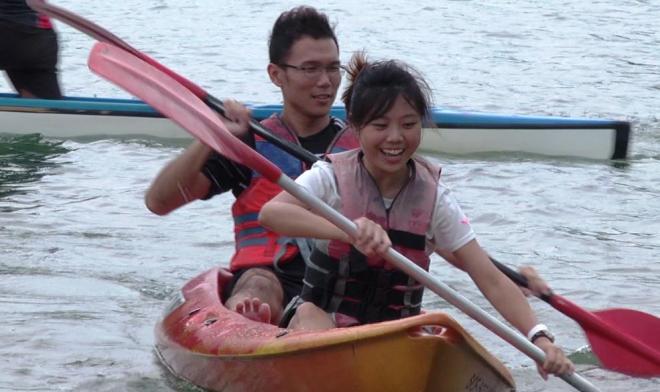Learn to Kayak: Adventure on water

Novices in kayaking can opt for a Recreational Kayak, which is easy to steer and has better balance (photo by Bryan Goh/SportSG).
By John Yeong
As temperatures soared to a sweltering 35 degrees Celsius over the weekend, many of my friends opted to take refuge in the comfort of their air-conditioned gyms for their weekly dose of exercise. A wise option perhaps, but that won't cut it if you're an outdoors type person looking for a fun alternative, and aren’t afraid of getting a bit wet in the process.
The latest Sports 101 series with ActiveSG takes our team to the Paddle Lodge at the serene MacRitchie Reservoir, where we were lucky enough to rub shoulders with Singapore’s very own Olympian Geraldine Lee and her Team Singapore teammates Tay Zi Qiang and Annabelle Ng. It was the perfect opportunity for beginners like Lecia and myself to pick up some tips on Kayaking.
Differences between Kayak and Canoe
So what should any novice kayaker take note of? We spoke to Zi Qiang, who gave us the low down on telling the difference between a canoe and a kayak, a common predicament most people unfamiliar with the two sports have.
Not only do the two come from different origins in history, there are also telling differences in the types of boats used, the paddles for each and even the position adopted in them.
Kayaking generally involves sitting in the boat, with legs oustretched, and a double blade paddle while Canoeing sees the canoeist adopting a kneeling position, and using a single blade paddle, much like those used in dragon boating.
There is also a distinct difference between competitive kayaks and recreational kayaking, with many competitive kayaks generally having rudders attached to help with turning the boat.
Basic Moves for Recreational Kayaking
Our conversation with Geraldine took us to the topic of recreational kayaking, and although shy and reluctant at first, she duly obliged to show us three basic moves for beginners: turning left, turning right, and stopping.
Basically to turn left when moving forward, the kayaker needs to thrust the blade of his/her paddle out to the left side of the boat at a forward angle and sweep the blade backwards. The same applies with turning right when moving forward, except that the kayaker now sweeps his paddle on the right side of the kayak.
When stopping, thrust the blade of the paddle vertically into the water with the blade facing forward. You will feel water resistance against the blade, take the blade out of the water abruptly, and thrust the other blade of the paddle into the other side of the boat to repeat the process. Jabbing the blades into the water aggressively on both sides of the boat quickly allows you to make a quick stop.
Watching our Team Singapore kayakers have so much fun in the water really tempted Lecia and I, and so we decided to get our hands dirty. Stumbling clumsily into the rubber dinghy, our attempts at executing Geraldine's instructions were far from the desired outcome to say the least. But while our brief adventure on MacRitchie's peaceful waters turned out to be more playful than studious, we are completely sold on the idea of kayaking as a sport for families and friends - not just to sweat it out but for the fun it brings.
So the next time you feel like taking a break from your monotonous gym routine on a hot day, why not take your family to MacRitchie's Paddle Lodge for a kayak session instead?
To receive the latest updates on the happenings in the Singapore sports scene, or to find out more about some of the latest programmes on offer at ActiveSG, like our Facebook page here.



